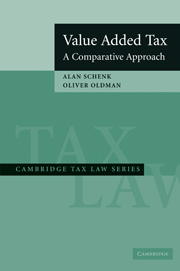Book contents
- Frontmatter
- Contents
- List of Tables, Figures, and Charts
- List of Cases
- Preface to the Revised Edition
- Value Added Tax
- 1 SURVEY OF TAXES ON CONSUMPTION AND INCOME, AND INTRODUCTION TO VALUE ADDED TAX
- 2 FORMS OF CONSUMPTION-BASED TAXES AND ALTERING THE TAX BASE
- 3 VARIETIES OF VAT IN USE
- 4 REGISTRATION, TAXPAYER, AND TAXABLE BUSINESS ACTIVITY
- 5 TAXABLE SUPPLIES OF GOODS AND SERVICES, AND TAX INVOICES
- 6 THE TAX CREDIT MECHANISM
- 7 INTRODUCTION TO CROSS-BORDER ASPECTS OF VAT
- 8 TIMING, TRANSITION AND VALUATION RULES
- 9 ZERO RATING AND EXEMPTIONS AND GOVERNMENT ENTITIES AND NONPROFIT ORGANIZATIONS
- 10 GAMBLING AND FINANCIAL SERVICES (OTHER THAN INSURANCE)
- 11 INSURANCE
- 12 INTERJURISDICTIONAL ASPECTS OF VAT IN FEDERAL COUNTRIES AND COMMON MARKETS
- 13 REAL PROPERTY
- 14 PROPOSALS FOR U.S. TAX ON CONSUMPTION
- APPENDIXES
- Index
14 - PROPOSALS FOR U.S. TAX ON CONSUMPTION
Published online by Cambridge University Press: 06 January 2010
- Frontmatter
- Contents
- List of Tables, Figures, and Charts
- List of Cases
- Preface to the Revised Edition
- Value Added Tax
- 1 SURVEY OF TAXES ON CONSUMPTION AND INCOME, AND INTRODUCTION TO VALUE ADDED TAX
- 2 FORMS OF CONSUMPTION-BASED TAXES AND ALTERING THE TAX BASE
- 3 VARIETIES OF VAT IN USE
- 4 REGISTRATION, TAXPAYER, AND TAXABLE BUSINESS ACTIVITY
- 5 TAXABLE SUPPLIES OF GOODS AND SERVICES, AND TAX INVOICES
- 6 THE TAX CREDIT MECHANISM
- 7 INTRODUCTION TO CROSS-BORDER ASPECTS OF VAT
- 8 TIMING, TRANSITION AND VALUATION RULES
- 9 ZERO RATING AND EXEMPTIONS AND GOVERNMENT ENTITIES AND NONPROFIT ORGANIZATIONS
- 10 GAMBLING AND FINANCIAL SERVICES (OTHER THAN INSURANCE)
- 11 INSURANCE
- 12 INTERJURISDICTIONAL ASPECTS OF VAT IN FEDERAL COUNTRIES AND COMMON MARKETS
- 13 REAL PROPERTY
- 14 PROPOSALS FOR U.S. TAX ON CONSUMPTION
- APPENDIXES
- Index
Summary
INTRODUCTION
Thomas S. Adams, an American, was one of the first commentators to discuss the concept of a VAT. Other than flirting with a possible federal sales tax as a source for revenue to finance World War II, the U.S. Congress has not seriously debated a proposal for a federal tax on consumption.
Retail sales taxes account for a significant share of state and local revenue, and at least one state relies on a state-level value added tax.
As discussed in Chapter 2, a consumption-based tax can take the form of an individualized consumption-based income tax (commonly referred to as a “consumed” or “cash-flow income tax) or the form of a consumption-based tax on sales of goods and services (single stage sales tax or multistage value added tax). This book has focused on the latter. Indeed, because most countries with consumption-based taxes rely on European-style VATs, this book concentrated on that kind of VAT.
On January 7, 2005, President Bush established a panel to recommend revenue-neutral options to reform the federal tax system to make it simpler, fairer, and more pro-growth to benefit all Americans. The panel issued its report on November 1, 2005. Although the panel received many submissions and discussed the possible introduction of a federal sales or value added tax, the panel did not include a transactional tax on consumption to supplement or replace any of the existing federal taxes on income, payroll, and wealth transfers. The next section discusses the panel's report.
- Type
- Chapter
- Information
- Value Added TaxA Comparative Approach, pp. 433 - 458Publisher: Cambridge University PressPrint publication year: 2007
- 1
- Cited by



